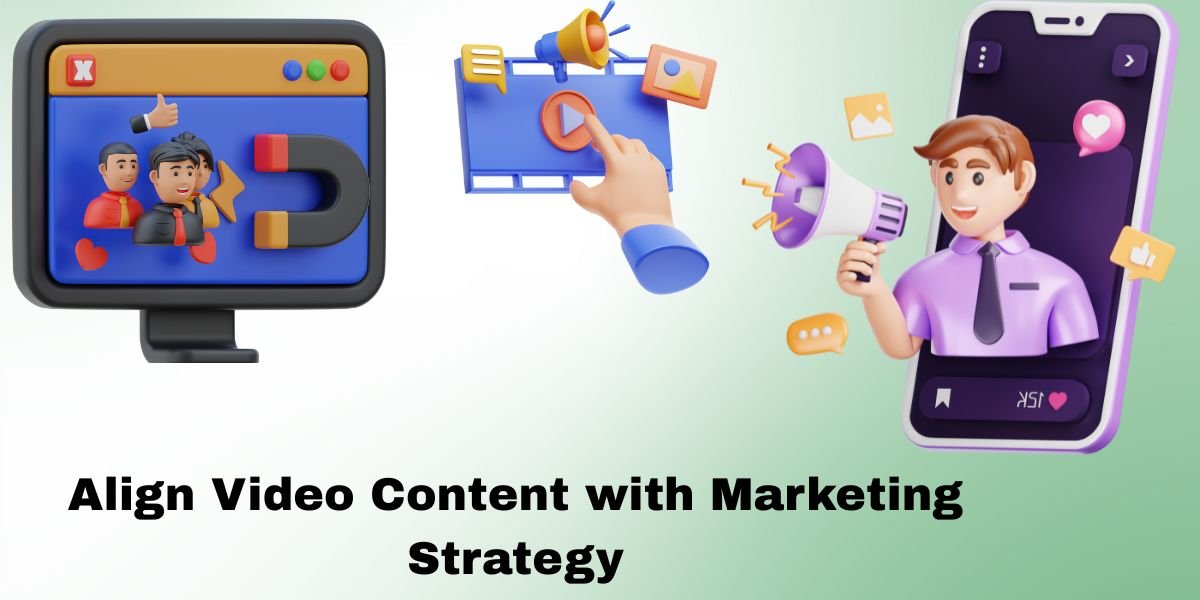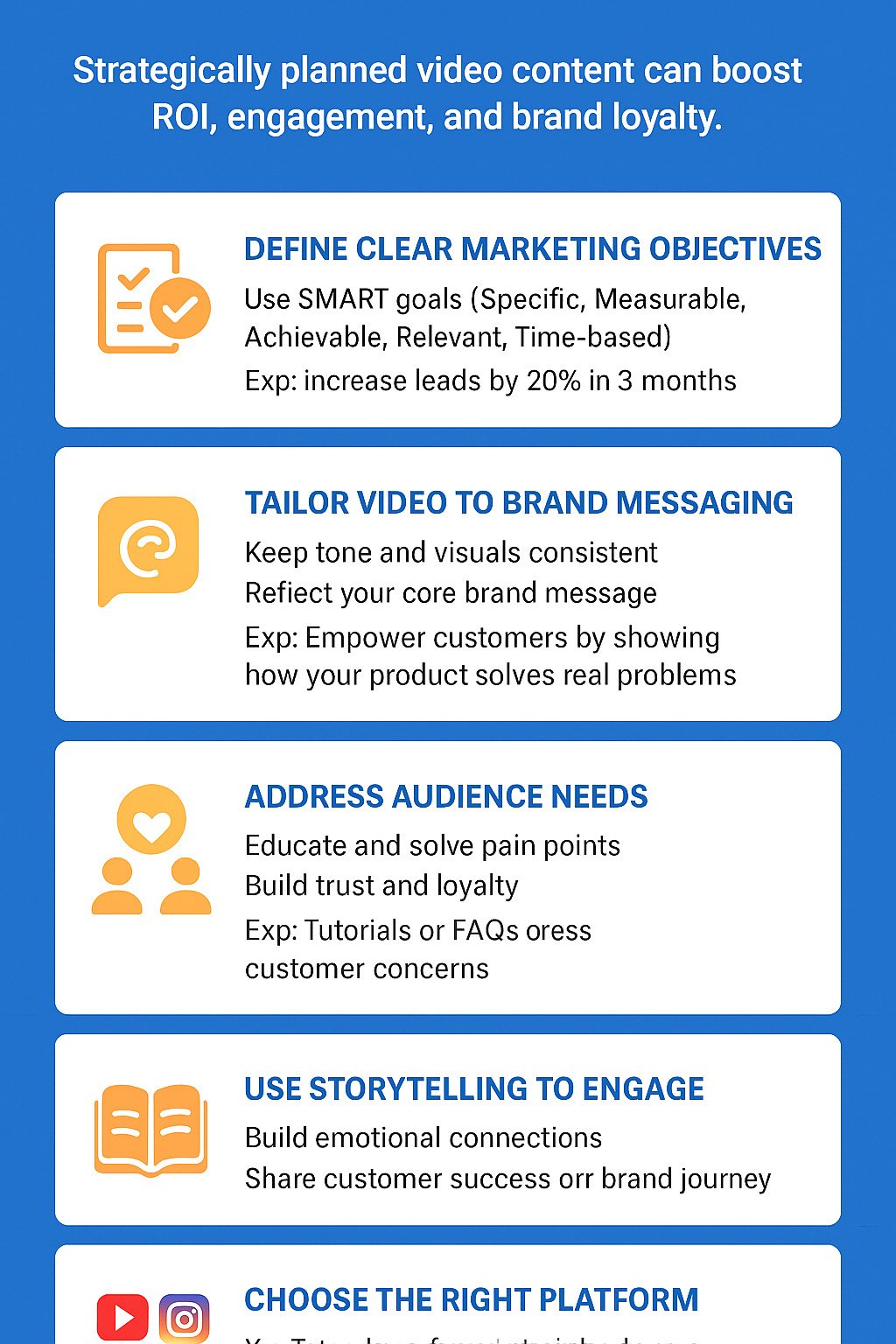The Best Guide to Align Video Content with Marketing Strategy
Published: 22 Sep 2025
In today’s digital landscape, video is one of the most powerful tools for marketers. However, creating visually appealing videos isn’t enough to achieve meaningful results. To truly maximize impact, it’s essential to align video content with marketing strategy. When your video content is strategically planned with clear objectives—whether it’s boosting brand awareness, generating leads, or educating customers—it delivers higher ROI, stronger engagement, and consistent brand messaging. By aligning your videos with your overall marketing goals, you create targeted, results-driven campaigns that capture attention and drive growth.

In this article, we’ll explore how to align your video content with your marketing goals effectively and why it’s essential for business growth.
Understand Your Marketing Objectives Before Creating Video Content
Before creating any video, it’s crucial to define your marketing objectives. Without clear goals, your video may not give the desired results.
- Start by using SMART goals: “Specific, Measurable, Achievable, Relevant, and Time-bound.” This framework helps you stay focused and ensures your video aligns with your overall marketing strategy.
- For example, if your goal is lead generation, your video content should educate viewers about your product or service and encourage them to take action. Whether filling out a form or signing up for a demo, your video should guide the viewer toward this specific outcome.
- When your goal is clear, you can tailor your video to meet it. This is what aligning video content with marketing objectives is all about. It ensures that every video you create has a purpose and a success for you.
- So, think: What do I want my video to achieve? Once you answer that, you’re ready to start crafting content that works for you.
Tailor Your Video Content to Support Key Marketing Messages
To make your videos stand out and connect with your audience, they must align with your brand’s core messaging. Video content should reflect the values and message you want to communicate, just like all your other marketing efforts. This ensures consistency and strengthens your brand’s identity.
Here’s how to align your video with your messaging:
- Know Your Brand’s Core Message
- What is the main message you want your audience to remember? Your video should echo that message. If your company focuses on customer empowerment, show how your product or service helps customers solve real problems. Make them feel like they are getting something valuable from you.
- Maintain Consistency in Tone and Visuals
- Ensure your video matches the tone, language, and visuals used in other parts of your marketing.
- If your brand is casual and friendly, your video should have a relaxed, approachable tone.
- If your brand is more professional, keep the video polished and informative.
- This will help viewers recognize your brand and feel they’re getting a consistent experience.
- Use Clear, Direct Messaging
- Keep your messaging simple and clear. Avoid confusing jargon. Your audience should understand your core message right away.
- Tie the Video Back to Your Marketing Goals
- Every video should be created with a specific marketing objective: brand awareness, lead generation, or customer education. Aligning video content with marketing objectives ensures that each video serves a purpose.
By tailoring your video content to your messaging, you are not just creating content—you’re reinforcing your brand’s identity and making a stronger connection with your audience. Consistency is key to building trust, and when your videos reflect your brand’s core message, you’re more likely to engage your viewers and drive results.
Create Videos That Speak to Your Audience’s Needs
To create impactful video content, focus on your audience’s needs and how your brand can solve their problems. Educational videos and thought leadership content are great ways to establish trust and position your brand as an expert.
Here’s why this works:
- Showcase Your Expertise
- Videos that teach or provide valuable insights build your authority in your industry. If your audience sees you as a knowledgeable resource, they will likely trust your brand and engage with your content.
- For example, an industry expert’s tutorial video or webinar helps showcase your expertise. This aligns perfectly with objectives like brand authority and customer trust.
- Solve Problems and Answer Questions
- Ensure your video answers your audience’s most common questions or addresses their pain points. When you provide solutions through your videos, you build credibility and trust. This can also lead to stronger customer loyalty.
- Focus on Value
- Your video should add value to your audience’s lives. Whether through tips, solutions, or new insights, always aim to educate and empower your viewers.
You align your content with your marketing objectives by creating videos that meet your audience’s needs. This builds trust and strengthens your brand’s relationship with viewers.

Craft a Story That Resonates With Your Audience
Storytelling is one of the most powerful tools in video marketing. When you create videos that tell a compelling story, you can connect with your audience on an emotional level. This emotional bond helps build brand loyalty and strengthens customer relationships.
Here’s why storytelling matters:
- Build Emotional Connections
- A well-told story can make your brand feel more human and relatable. When viewers connect emotionally with your brand, they’re more likely to engage and remain loyal.
- Example: A video about how your company started, what challenges you faced, and how you help your customers can build a strong narrative. This aligns with brand storytelling and boosts brand awareness.
- Enhance Brand Appeal
- A narrative that reflects your marketing objectives, such as brand awareness or customer engagement, can help you reach your goals more effectively. When your story resonates with your audience’s values or needs, it encourages them to share and interact with your content.
- Create a Strong Message
- Focus on a simple message that relates to your marketing objectives. Whether showcasing your product’s impact or telling a customer success story, your story should reflect the values that matter most to your brand.
Incorporating storytelling into your videos makes them more engaging, memorable, and aligned with your marketing goals. This helps create deeper connections with your audience and fosters long-term loyalty.
Choose the Right Format and Platform for Your Video Content
Not all video formats work the same across platforms. Each social media channel has its strengths and preferences. To achieve your marketing goals, it’s important to tailor your video content to the specific platform you’re using.
Here’s how to adapt:
- Know the Platform’s Strengths
- Different platforms support different types of video.
- Instagram favors short, visually engaging videos. Think of quick, attention-grabbing clips that are easy to consume. This format is great for brand awareness or engagement.
- YouTube, on the other hand, is ideal for longer, more in-depth videos. It’s perfect for tutorials, product demos, or thought leadership content. These videos can help with customer education and lead generation.
- Tailor Your Content to Platform Needs
- Creating platform-specific videos helps align your content with your marketing objectives. For instance, if your goal is customer loyalty, you should share tutorials or behind-the-scenes content on YouTube. Instagram Stories or Reels could be more effective if you want to build excitement for a new product.
- Match the Video Length and Style
- Each platform has an optimal video length and style. Make sure your video fits the expectations of your audience on each platform. This ensures higher engagement and better results.
Adjusting your video format to the platform will enhance alignment with your marketing goals and improve your video’s overall effectiveness.
Measuring the Success of Your Video Content Strategy
You must track key performance metrics to ensure your video content is effective. Measuring success is an essential step in aligning video content with marketing objectives. It’s hard to know if your videos achieve the desired results without proper tracking.
Key metrics to track include:
- Views: Are people watching your videos?
- Engagement rate: How many people interact with your content (likes, comments, shares)?
- Conversions: How many viewers are taking the desired action (e.g., signing up, purchasing)?
- Audience retention: Are viewers sticking around to watch the full video?
Regularly analyzing these metrics allows you to adjust your video content to meet your marketing goals. A/B testing can also be helpful. Test different video formats, lengths, or messaging to see what works best. This process allows you to refine your video strategy over time.
Tip: Consistent analysis will help you make necessary adjustments to improve your video content, ensuring better alignment with your marketing objectives and better business results.
Final Remarks
In conclusion, aligning video content with your marketing objectives is ongoing. It starts with setting clear goals, tailoring your content to match those goals, and choosing the right formats and platforms. Measuring success and making adjustments is key to staying on track.
Keep evaluating and refining your video strategy to build a strong brand presence and drive results. The more closely your videos align with your marketing objectives, the more likely you will see improved engagement, higher conversions, and a stronger brand.
Call to Action: Take a moment to review your current video strategy. Are your videos truly aligned with your marketing objectives? If not, it’s time to adjust and start creating content that works.

- Be Respectful
- Stay Relevant
- Stay Positive
- True Feedback
- Encourage Discussion
- Avoid Spamming
- No Fake News
- Don't Copy-Paste
- No Personal Attacks

- Be Respectful
- Stay Relevant
- Stay Positive
- True Feedback
- Encourage Discussion
- Avoid Spamming
- No Fake News
- Don't Copy-Paste
- No Personal Attacks



